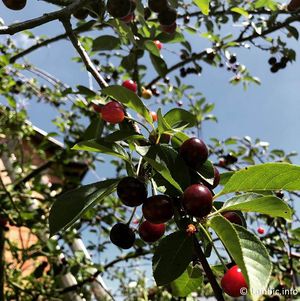Kriek
Description
A Kriek is a type of fruit lambic made with sour cherries. In Flemish, the word "Kriek" means sour cherry. While some non-lambic beers also use Kriek in their names, this page will refer only to Krieks which are lambics.
Kriek is one of the most common and oldest types of fruit lambic. Clear records of and recipes for Kriek production date at least to the beginning of the 1900s[1] (see also Cantillon Framboise) and documentation of local sour cherries being sold to brewers in the Brussels area dates back to at least the late 1700s, providing strong evidence for a much longer tradition of kriek production[2]. Bottled Kriek can be found both carbonated and still, with bottles labeled "Kriek" or "Oude Kriek" generally found carbonated and bottles with labels such as "Kriek lambiek" and "Kriekenlambik" generally uncarbonated.
Kriek terminology receives some legal protection in the EU. For example the terms "Kriek" and "Kriekenlambiek" denote certain specific process requirements (e.g. fermentation, age, cherry content) and final beer characteristics[3]. Similarly, the terms "Oude Kriek" and "Vieille Kriek" denote specific process and final beer characteristics as for "Kriek-Lambic", as well as additional final beer parameters, a secondary refermentation in the package and aging on lees[4] (see also Lambic Regulation).
Kriek production

Modern krieks are generally produced by macerating whole fresh or frozen cherries with lambic, though some less traditional producers use cherry-flavored syrups. Fermentation and aging of krieks often takes place in stainless steel tanks, though some producers use barrels or foeders for Kriek production. Fruiting rates, maceration times and the ages of lambic used varies between producers and specific products. For example, Brasserie Cantillon reports using 2 year old lambic and a maceration time of 1-2 months to produce Cantillon Kriek, which is blended back with young lambic for carbonation and to reach a final fruiting rate of 200 g/L before bottling[5]. Cantillon's Lou Pepe Kriek also uses 2 year old lambic, but has a fruiting ratio of 300 g/L and is not blended back with young lambic,[5]. Cantillon's Kriek is made with organic Morello cherries from Turkey and Lou Pepe Kriek is made from Schaerbeek cherries. Brouwerij 3 Fonteinen uses a maceration time of roughly 6 months [6] and lambic of roughly 1 year old. Brouwerij Boon macerates young lambic with cherries in oak vats for 6-8 months to produce Oude Kriek Mariage Parfait and macerates 1 year old lambic with cherries in steel tanks to produce Oude Kriek, both of which have a fruiting ratio of 400 g/L[7][8]. Oud Beersel also reports a fruit ratio of 400 g/L[9]. Hanssens uses one year old lambic and steeps cherries for nearly one year for their Oude Kriek[10]
Cherry types and cherry origins also vary between different brewers and blenders and between different products. One of the traditional Belgian sour cherry varieties used for Kriek production is the Schaerbeek cherry (Sometimes written "Schaerbeekse cherry" or "Schaerbeekse krieken"). Due to the limited availability of traditional Belgian sour cherries, such as Schaerbeek cherries, many producers are now sourcing other varieties of cherries from abroad. For example, Boon uses frozen cherries from Poland, which are have also been supplied to smaller blenders[10][11]. However, with a growing interest in traditional Schaerbeek cherries, some breweries are involved in projects to expand local production of this variety[12].
Historic production
Historic kriek production took place in wooden barrels or fouders. Square openings in the tops of barrels made it easier to get fruit into and out of the barrels. Older barrels with square bungs can still be seen in the cellars of some lambic producers; however, these are much less common than the typical round bung barrels in use today.
A recipe for kriek from 1907 details the following process information to produce a kriek[1][13]:
- Use lambic of roughly 2 years old.
- Use 160-200 g cherries (preferably Schaerbeek, but sometimes Cerise du Nord and Schaerbeek were used) per L lambic.
- In addition to cherries, a sugar syrup was added along with 10 g Ceylon cinnamon per 100 L lambic. Macerate for 4-5 months.
- Bottle and condition for roughly 6 months, at a maximum temperature of 15-17° C, after which the beers is carbonated and ready.
The resulting beer would age well for about 5 years.
Commercial Examples of Kriek
Below is a brief list of some traditional (unsweetened, bottle conditioned) Krieks. A more comprehensive list of Krieks can be found on the individual pages for lambic brewers and blenders.
- 3F Oude Kriek
- Boon Oude Kriek and Oude Kriek Mariage Parfait
- Cantillon Kriek
- De Cam Oude Kriek and Kriek Lambiek (sometimes made with Schaerbeekse cherries)
- Hanssens Oude Kriek
- Lindemans Oude Kriek Cuvée René
- Oud Beersel Oude Kriek Vieille
Krieks made with Schaerbeek cherries
- 3 Fonteinen Schaerbeekse Kriek
- Cantillon Lou Pepe Kriek
- De Troch Oude Kriek
- Hanssens Scarenbecca Kriek
- Oud Beersel Schaarbeekse Oude Kriek
References
- ↑ 1.0 1.1 Petit Journal du Brasseur (1907). p.531-532 & 547-548
- ↑ Eugène-Joseph-Charles-Gilain-Hubert d'Olmen baron de Poederlé, (1792). Manuel de l'Arboriste et a du Forestier Belgique.
- ↑ TSG for Kriek
- ↑ TSG for Oude Kriek
- ↑ 5.0 5.1 Brasserie Cantillon - Tour Brochure (English)
- ↑ 3 Fonteinen Oude Kriek labels
- ↑ Boon Oude Kriek Mariage Parfait
- ↑ Oude Kriek Boon
- ↑ Oud Beersel Oude Kriek
- ↑ 10.0 10.1 Webb, Pollard & McGinn, 2010. Lambicland: A journey round the most unusual beers in the world
- ↑ Van den Steen, 2011. Geuze & Kriek: The Secret of Lambic
- ↑ Schaerbeek Cherry orchards from Cantillon & Vert d'Iris
- ↑ | Hors Catégorie Brewing blog post on Kriek from 1907